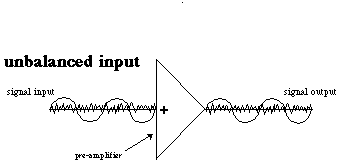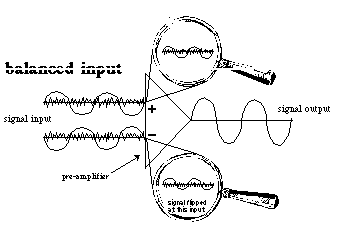|
What's all the talk about things being balanced and unbalanced?
Who cares if two cables will balance on a teeter-totter or not?
Seriously, what's the difference and why does it matter?
First, a little background on cable construction. All low signal
level audio cables are shielded--that is, the inner conductor(s)
have a shield of wrapped or braided wire, or foil wrapped around
the outside of the center conductor(s). This shield blocks RFI
(radio frequency interference) from entering the cable. Besides
just picking up noise, if an audio cable isn't shielded well
(or at all), as the length of the cable approaches the length
of a transmitted radio wave, the cable turns into an antenna.
This antenna then picks up the transmitted radio wave very clearly!
A consumer tape deck, CD player, and VCR all have unbalanced
audio outputs. An unbalanced output is one where the audio signal
is conducted through two wires to provide a simple circuit.
An unbalanced cable has two wires--a center conductor and the
shield. The shield serves to drain the RFI as well as acting
as a conductor to complete the circuit. The trouble is that
if two pieces of interconnected equipment are both ground referenced
(if they have a grounded AC plug or are otherwise grounded),
a ground loop can be formed between the two units. To fix this
problem, the ground wire at the receiving end of the audio cable
can be disconnected, but then the audio circuit path includes
the signal going through the grounding system, which introduces
ground noise.
A second problem is that where connections are longer than
a few feet, the possibility of EMI (electromagnetic interference)
from power cables increases. Every wire carrying power has a
magnetic field around it. This includes AC power wires, speaker
level cables (from amplifiers), and even other microphone or
line level cables. EMI noise shows up as humming, buzzing, and
static. The problem may be constant, or it may be intermittent
(if the cables producing the EMI are powering a device that's
not used constantly).
The diagram below shows the input stage of a mixer. An unbalanced
input passes both the audio signal and noise to the output.
OK, now that we have a basic understanding of how an unbalanced
connection works, what about balanced? A balanced connection
uses a total of three wires--the ground/shield, and two wires
that both carry the audio signal (but opposite polarity of each
other). As you can see from the balanced circuit diagram, the
two signal wires both carry the audio signal (curved sine wave),
but the signal is opposite on the negative wire. Noise that's
induced onto the two wires is induced equally on both wires.
When the signal gets to the equipment input, the negative (opposite)
signal is inverted (reversed) and added to the positive input
signal. The audio signals are then in correct polarity with
each other, and add up nicely. On the other hand, any noise
carried by the wires cancels out because the one signal has
been inverted. Notice that the output contains only the clean
audio signal and no noise.

Balanced inputs on equipment have a CMRR (common mode rejection
ratio) number that tells you how well the input can reject a
signal (such as noise) that's common to both inputs. The higher
the number, the better it is. (CMRR decreases with an increase
in frequency because it's difficult to maintain the same capacitance
and inductance to ground in each leg of the wiring and circuitry.)

Many, many churches have key cable runs (mixer to EQ to amplifier)
connected unbalanced, and they wonder why the system is noisy.
It's not uncommon to run new cable, make new connections (all
balanced), and have the hum and noise totally disappear.
Balanced circuits are always better than unbalanced, but there
are many factors which determine how good a balanced input or
output is. This can affect overall performance.
Balanced connections are made using XLR connectors, 1/4"
TRS (tip-ring-sleeve (stereo)) connectors, or just bare wires
(using 3 wires). Unbalanced connections use 1/4" TS (tip-sleeve
(mono)) connectors, RCA connectors, and bare wire terminations
(where only 2 wires are used). Even if a connection uses an
XLR or 1/4" TRS connector, all 3 wires may not be used
(and so it may still be unbalanced)! Short runs (less than 5
feet) of unbalanced cable to/from tape decks, CD players, or
VCR's isn't as much of a problem.
Check your sytem for unbalanced connections--and have them
changed to balanced connections as soon as possible! Give us
a call for help in solving your noise problems. |